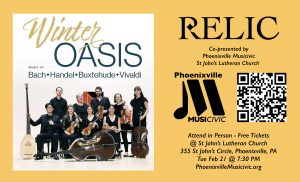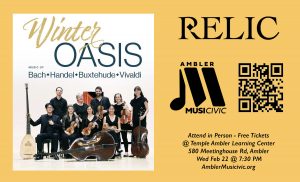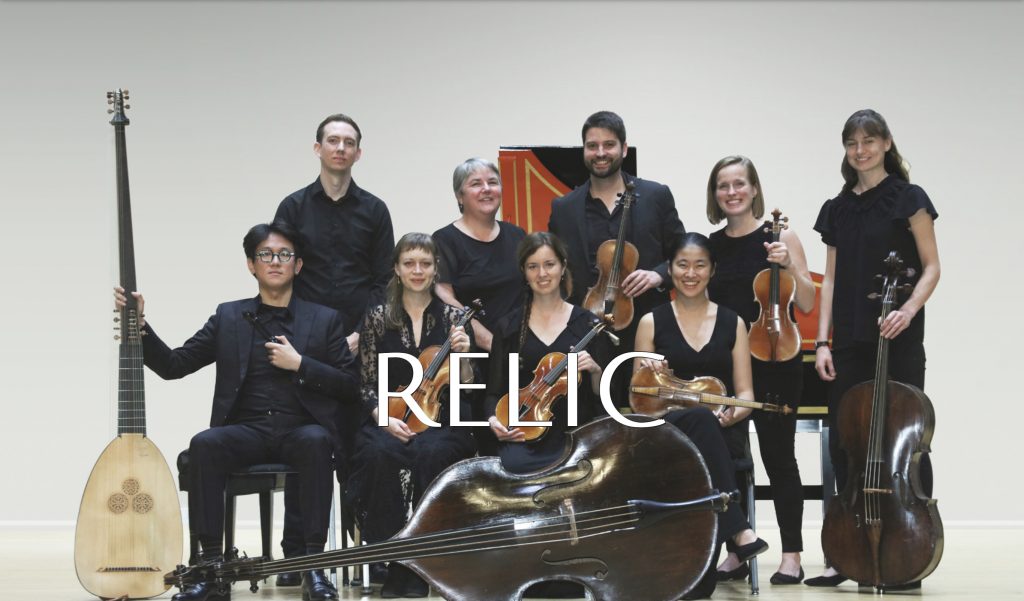Artists
Program
Preview
Performances
Bios
Performances


Artists
Relic is a conductorless period chamber orchestra that aims to connect with audiences through intimate, innovative and dramatic representations of early music, and to present these performances to communities in all 50 states. Members of Relic perform on original eighteenth century instruments, or their replicas, and are fluent in the improvisational and ornamental languages of the Baroque and Classical era.
Sponsored By

Both the Ambler Musicivic and Poenixville Musicivic perfomances are made possible in part by funding from the Music Performance Trust Fund and by Musicivic, Inc.
Program
Join Relic on a journey through the depths of winter. This program leans heavily on the mysterious and austere power of German sacred baroque repertoire to explore the external darkness and internal warmth we experience at the heart of winter. The music weaves through a series of querulous, bleak, and stir-crazy episodes toward an oasis of celestial solace, before coming to a fiery finish in Vivaldi’s beloved Concerto for Four Violins.
Concert Program ~ Darkness Descends ~ Henry Purcell (1659-1695) Overture from Dido and Aeneas, Z. 626 Georg von Bertouch (1668-1743) Sonata á 3 No. 13 in C minor II. Andante IV. Vivace ~ A Landscape Frozen Still ~ Dietrich Buxtehude (1637-1707) Sonata Ad cor from Membra Jesu nostri, BuxWV 75 Matthias Weckmann (1616-1674) Sinfonia from Zion spricht, der Herr hat mich verlassen Franz Tunder (1614-1667) Sinfonia á 7 viole D. Buxtehude Sonata Ad latus from Membra Jesu nostri, BuxWV 75 Sinfonia from Jesu, meines Lebens Leben, BuxWV 62 Francesco Durante (1684-1755) Concerto for Strings No. 2 in G minor II. Presto ~ Sweeping Winds, Dancing Stars ~ Jean-Marie Leclair (1697-1764) Première récréation de musique, Op. 6 I. Ouverture George Frideric Handel (1685-1759) Concerto Grosso in B minor, Op. 6, No. 12, HWV 330 I. Largo II. Allegro Concerto Grosso in D major, Op. 6, No. 5, HWV 323 V. Allegro ~ Winter Oasis ~ Johann Sebastian Bach (1685-1750) Sonatina from Gottes Zeit ist die allerbeste Zeit, BWV 106 D. Buxtehude Sonata from Gott hilf mir, denn das Wasser geht mir bis an die Seele, BuxWV 34 J. S. Bach Sonata from Himmelskönig, sei willkommen, BWV 182 Sinfonia from Der Herr denket an uns, BWV 196 Christoph Graupner (1683-1760) Overture in F major, GWV 445 V. Le Desire Johann Pachelbel (1653-1706) Suite No. 4 in C major, P. 374, from Musicalishe Ergötzung IV. Ciacona ~ Into the Flickering Fire ~ Antonio Vivaldi (1678-1741) Concerto for Four Violins in B minor, Op. 3, No. 10, RV 580, from L’estro armonico I. Allegro II. Largo—Larghetto—Adagio—Largo III. Allegro Musicians Aniela Eddy*, violin and viola Toma Iliev*, violin and viola Natalie Rose Kress*, violin and viola Kako Miura*, violin and viola Rebecca Nelson*, violin and viola Georgeanne Banker, bassoon Cullen O’Neil*, cello Sue Yelanjian, double bass Menglin Gao, theorbo Cameron Welke, Baroque guitar and theorbo Robert Warner, harpsichord and viola *Relic founders Notes on Winter Oasis by Cullen O’Neil I. Darkness Descends In the bleak midwinter, frosty wind made moan, Earth stood hard as iron, water like a stone; Snow had fallen, snow on snow, snow on snow, In the bleak midwinter, long ago. -Christina Rossetti We are ushered into our winter landscape with the overture to English composer Henry Purcell’s best-known tragic opera, Dido and Aeneas. The opening section of the overture, full of foreboding, transitions into a severe and incessant faster section that eventually gives way to two wandering movements from a trio sonata by the little-known German composer Georg von Bertouch. Taken from Bertouch’s notable collection of twenty-four sonatas written in each of the twenty-four keys, this sonata explores the searching and melancholic key of C Minor. II. A Landscape Frozen Still Wandering through cold streets tangled like old string, Coming on fountains rigid in the frost, Its formula escapes you; it has lost The certainty that constitutes a thing. -W. H. Auden In this chapter, several brief but powerful instrumental sections—most of them excerpted from early German sacred cantatas—express the grief and desolation of winter’s darkest hour. From Weckmann’s Zion spricht, der Herr hat mich verlassen (Zion speaks, the lord has abandoned me), toBuxtehude’s “Ad cor” (To the heart) and “Ad latus” (To the sides), which come from a collection of seven cantatas each devoted to a different part of Jesus’s crucified body, this chapter draws from the angst and asceticism of German Lutheranism to paint an icy winter canvas. At the end of the chapter, a brusque and bizarre concerto by the Italian Francesco Durante wakes us abruptly from our mediation and catapults us into Chapter III. III. Sweeping Winds, Dancing Stars Along the terrace wall Snowdrops have pushed through hard ice, making a pool. Delicate stems now show White bells as though The force, the thrust to flower Were nothing at all. Who gives them the power? -May Sarton Two textures characterize Chapter III: the pointed and powerful dotted rhythm of the introductory movements, and the shimmering, active texture of the quicker sections. Overall, a feeling of immense but restrained energy permeates the chapter, like a stir-crazy afternoon at the end of long and dreary winter. IV. Winter Oasis And like some frozen thing that feels the sun Through solitudes of winter penetrate, The frolic currents through my senses run; While fluttering whispers soft and intimate Out of the ruddy firelight of the grate Make talk, love, music, poetry in one. -Christopher Pearce Cranch At last, a chapter of solace and warmth—as though in the midst of a frigid snowstorm, you stumble upon a log cabin while trudging through the snow and are welcomed in to sit by the hearth. Profound relief, quiet meditation, friendly conversation, and whimsical daydreams come to mind as the chapter drifts through many of the program’s only major keys. Featuring later Baroque Germans—Johann Pachelbel, Christoph Graupner, and of course Johann Sebastian Bach—Chapter IV showcases another side of German Lutheranism: the supreme peace and comfort of heaven’s promise. V. Into the Flickering Fire With torn and living tongues the flames leap. Hungrily They catch and lift, to beat their sudden wings Toward freedom and the sky. -Eunice Tietjens As though bolstered by the warmth of the hearth, we burst into fiery song with Antonio Vivaldi’s well-loved Concerto for Four Violins. As the violins, violas and cello pass the solo line from one person to the next, each trying to outdo the other, the rest of the orchestra offers a rough and raucous accompaniment. Feel the flames flicker and flare in this final number, igniting your spirit and sending you bravely into the bitter night. About Relic Relic is a period chamber orchestra founded in 2022 by six Juilliard graduates with the mission to bring live performances of early music to communities in every corner of the country (and the world!). Currently in its very first season, Relic has quickly built a reputation for its intimate, dramatic, cutting-edge performances of both well-loved and lesser-known masterworks of the Baroque era. Members of Relic play on historical period instruments and are fluent in the stylistic idioms of music from the Renaissance through the Romantic eras. Historic music performed by Relic is thus infused with the same excitement as if it were created in the present; in fact, much of the music is conceived here and now, as the ornamentation and harmonic realization are improvised according to historical practices—just as they would have been back then. Experience 1630s Lübeck, 1730s London, and more on a journey through time with Relic!
Ensemble Preview
Bios
Visit Relic page for musician Bios.

